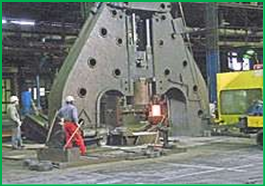Forging is a manufacturing process involving the shaping of metal using localized compressive forces. Forging is often classified according to the temperature: “cold”, “warm”, or “hot” forging.
Forged parts can range in weight from less than a kilogram to 580 metric tons. Forged parts usually require further processing to achieve a finished part.

Some metals may be forged cold, but iron and steel are almost always hot forged. Hot forging prevents the work hardening that would result from cold forging, which would increase the difficulty of performing secondary machining operations on the piece.
While work hardening may be desirable in some circumstances, other methods of hardening the piece, such as heat treating, are generally more economical and more controllable. Alloys that are amenable to precipitation hardening, such as most aluminium alloys and titanium, can be hot forged, followed by hardening.
A forging press, often just called a press, is used for press forging. There are two main types, the mechanical and hydraulic presses:
Mechanical presses – function by using cams, cranks and/or toggles to produce a preset (a predetermined force at a certain location in the stroke) and reproducible stroke. Mechanical presses are faster than their hydraulic counterparts (up to 50 strokes per minute). Their capacities range from 300 to 18,000 short tons-force.
Hydraulic presses – use fluid pressure and a piston to generate force. The advantages of a hydraulic press over a mechanical press are its flexibility and greater capacity. The disadvantages include a slower, larger, and costlier machine to operate.
The roll forging, upsetting, and automatic hot forging processes all use specialized machinery.
Wrought Iron:
Wrought iron is an iron alloy with very low carbon content in comparison to steel, and has fibrous inclusions, known as slag. This is what gives it a “grain” resembling wood, which is visible when it is etched or bent to the point of failure.
Wrought iron is tough, malleable, ductile and easily welded. Historically, it was known as “commercially pure iron”, however, it no longer qualifies because current standards for commercially pure iron require a carbon content of less than 0.008 %.
Before the development of effective methods of steel making and the availability of large quantities of steel, wrought iron was the most common form of malleable iron. Demand for wrought iron reached its peak in the 1860s with the adaptation of ironclad warships and railways, but then declined as mild steel became more available.
A modest amount of wrought iron was used as a raw material for manufacturing of steel, which was mainly to produce swords, cutlery, chisels, axes and other edge tools, as well as, springs and files.
Wrought iron is no longer produced on a commercial scale. Many products described as wrought iron, such as guard rails, garden furniture and gates, are made of mild steel.
The items produced from wrought iron include rivets, nails, wire, chains, railway couplings, water and steam pipes, nuts, bolts, horseshoes, handrails, straps, roof trusses and ornamental ironwork.
Many structural metals undergo some special treatment to modify their properties, so that they will perform better for a different use. This treatment can include mechanical working, such as rolling or forging, alloying and/or thermal treatments.
As an example, commercially pure aluminum (1100) has a tensile strength of around 13,000 psi, which limits its usefulness in structural applications. However, by cold-working aluminum, its strength can be approximately doubled.
Strength increases are obtained by adding alloying metals such as manganese, silicon, copper, magnesium and zinc and many aluminum alloys are strengthened by heat treatment. Some heat- treatable aluminum alloys obtain tensile strengths that can exceed 100,000 psi.
For more information and trainings for NDT, courses on NDT, welding courses we have our training institute open to all, visit us at https://aqcinspection.com/training/. For Non destructive testing services and material testing , welding inspection services , visit https://aqcinspection.com/non-destructive-testing/









